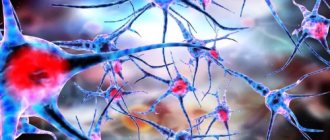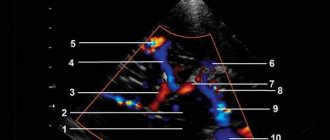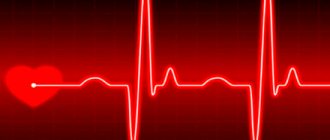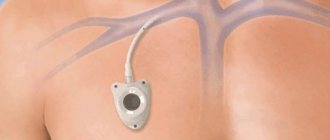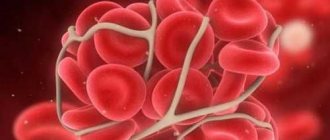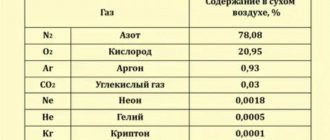05/10/2021 | Category Symptoms of cervical osteochondrosis
Many who had an ultrasound of the neck saw in the conclusion the phrase “impaired venous outflow.” Let us immediately note that if this is discovered, this is already good, it means that the doctor looked carefully, not in a hurry, and did not miss anything. Sometimes there is no such record, although in fact there is a problem. The lack of recording may be due to various reasons, including due to outdated equipment; we will not dwell on this, but further we will describe the factors and symptoms by which it can be understood that the venous outflow is impaired, even if this is not indicated by the ultrasound results.
What is a venous outflow disorder?
First of all, let's understand the anatomy. Imagine a spine. Veins run next to it, through which blood should flow freely from the head down. If the vertebrae are displaced, then the veins can be pinched, deformed, and because of this their capacity is reduced. Blood accumulates in the posterior cranial fossa.
With normal intracranial pressure, there is no outflow of blood through the compressed vessels. In order for the outflow to be restored, the blood must flow with greater pressure, that is, the pressure must increase. We all know that increasing blood pressure is not beneficial for the body, to put it mildly, and here it is a necessary measure to restore blood circulation, otherwise more serious problems will arise.
In the long term, stagnation of blood and impaired circulation in the brain are fraught with many bad consequences, but there is no need to be afraid. The human body is excellent at recovering on its own, plus it informs in advance about possible problems with unpleasant and even painful sensations. Therefore, you need to listen to your body and simply help it be healthy, which is not difficult to do.
After an increase in pressure, a sharp outflow occurs through the posterior or jugular veins. Changes in the condition of the jugular veins are easier to see on an ultrasound than changes in the vessels near the spine, on the back of the neck.
Helpful advice
When you go for an ultrasound, be sure to ask to look at the jugular veins. If they write to you that they are dilated, this is an accurate sign of venous stagnation and circulatory disorders in the brain.
Reference. It is more difficult to see a similar sign of a disorder in the spine. Therefore, it may be that the problem is already there, but it is not yet visible when examining the back of the neck.
The jugular veins dilate and lose elasticity when large volumes of blood are dumped through them. As a result, blood circulation worsens even more, and the body signals this with pain.
Improving blood circulation in the brain - vitamins
Among the vitamins for improving blood circulation in the brain, one can highlight Vitamin B5 (pantothenic acid), which is necessary for the functioning of nerve fibers, the division of epithelial cells and the formation of the inner wall of blood vessels. Vitamin B6 (pyridoxine) is involved in the functioning of the nervous system, is necessary for the formation of a number of neurotransmitters, and reduces the level of lipids in the blood. Vitamin B8 (inositol) is part of the protective membrane of brain cells, stabilizes lipid metabolism, and normalizes mood.
Vitamin C (ascorbic acid) normalizes blood clotting, stabilizing blood flow, stabilizes capillary permeability, and is an antioxidant. Also, complexes with minerals - phosphorus, magnesium, selenium and zinc - are useful to improve blood circulation in the brain. All these minerals are necessary to maintain the functioning of brain cells. Examples of such complexes are Magnesium + Vitamin B6, Zinc + Vitamin B6, Multivitamin complex 360.
Symptoms of impaired venous outflow
Headache
The most common symptom is pain due to increased intracranial pressure. The blood does not leave the head on time, and new portions of it continue to flow - the pressure rises, the body signals this with a headache.
A case from the practice of Dr. Shishonin
The man was diagnosed with migraine and prescribed medication. The patient took the pills with discipline, but there was no noticeable improvement. Migraine attacks did not become less frequent and were often as severe as before starting to take the drugs. The attack was very difficult to relieve with analgesics; you had to take the maximum allowable doses, and even they did not always work. The pain went away on its own after some time.
Dr. Shishonin recommended going for an ultrasound under the compulsory medical insurance policy and asking to look at the jugular veins. An ultrasound showed that they were dilated. The cause of the migraine became clear - increased intracranial pressure.
After conservative non-drug treatment, improvement occurred within two months.
Extreme migraine
A very painful symptom occurs due to loss of elasticity of the jugular veins. Up to a certain point they can withstand the increased load, and then they can no longer cope. Swelling appears in the brain stem. They are not yet dangerous to human life and health, but they cause severe pain in the ternary nerve.
This is an extreme degree of migraine, it is almost impossible to tolerate and difficult to relieve with analgesics. A person becomes incapacitated, no matter how strong his will is. In addition, nausea occurs, the patient is physically unable to drink liquids or eat food. A migraine can last a day and goes away on its own when the pressure rises to such an extent that blood discharge does occur. If such conditions are repeated frequently, it becomes potentially dangerous.
Ptosis of the eyelid
A case from the practice of Dr. Shishonin
The person suddenly developed ptosis and the mobility of the eyelid was impaired. The hospital carried out a full examination - a microstroke was not confirmed, and no tumor was found.
An ultrasound scan examined the veins in the neck and revealed gross venous congestion. Conservative treatment without pills gave results after six months. If a person had paid attention to the headaches that he often had earlier, the problem could have been solved faster.
Labored breathing
This symptom itself is ambiguous; there can be many reasons. But if it is accompanied by regular pain in the back of the head or temples, then the cause is most likely venous stagnation.
Lack of air due to a violation of venous outflow can occur either unexpectedly and without cause (not during physical activity, not in a stuffy room), or, as they say, out of the blue - during a walk, in a well-ventilated room. If such situations recur, and under different conditions, you need to check and treat the neck first.
What else you need to know about symptoms
There are many signs of circulatory problems. Any discomfort in the head, neck, chest, or upper back may indicate this problem. You need to undergo an examination, and in any case it will be useful to do simple exercises. Unlike pills, carefully performed gymnastics and gentle self-massage have no side effects, that is, in any case the condition will not worsen.
The main principle of the doctor is Primum non nocere (“First of all, do no harm”). Therefore, Dr. Shishonin recommends making maximum use of the natural recovery abilities inherent in our body.
A unique treatment method with turpentine solution
A. S. Zalmanov, developing the ideas of Kneipp, Schweninger, Winternitz and Valinsky about various kinds of water procedures, created a unique treatment method with turpentine solution, which allows you to vary the effect of water procedures on capillaries . This is a great therapeutic weapon for the medicine of the future.
Subscribe to our Yandex Zen channel!
Treatment with turpentine baths can be used in any small apartment that has a bath.
There is not a single disease of the bones or joints with hypercalcification or hypocalcification, there is not a single ankylosis of the joints with muscle atrophy, not a single chronic blockage of blood vessels (“Buerger’s disease”) that would not respond to turpentine baths.
This thermal procedure can be used at home for the following diseases:
- progressive deforming rheumatism;
- persistent sciatica;
- neuritis and polyneuritis;
- consequences of infantile paralysis;
- consequences of fractures and disfiguring scars;
- intermittent claudication;
- consequences of cerebral hemorrhage; angina pectoris;
- scleroderma;
- elephantiasis (edema).
How can you help yourself without pills?
There are two simple ways. The first can be used by each person independently without preparation. The second one is a little more difficult, but regular viewers and readers of Dr. Shishonin will master it very quickly.
It is better to use both methods: working on the points on the sides of the front of the neck, and working under the back of the head. This way, you will not only get rid of headaches and other symptoms of impaired venous outflow, but you will also feel more energetic, your mood and memory will improve. The main thing is to regularly devote time to yourself and help your body recover. The capabilities of the human body are almost limitless, but you need to develop them by doing gymnastics and self-massage.
Anatomical features
To understand the disease, it is important to understand the anatomy. Knowing the features of the structure of all parts of the head, both hemispheres of the brain and blood vessels, it will become easier to even identify this disease.
The venous wall of the brain does not have a valve apparatus, which is why the blood disperses freely through all adjacent vessels on different sides of the head. Almost all of them are located at a distance from each other and from the arteries. Venous sinuses are intermediate points for blood with cerebrospinal fluid from the ventricles. Vessels emerge from them. They come in two types: superficial and deep. The first are located inside the pia mater in the interlobar grooves; they are responsible for the flow of blood from the cerebral cortex to the cerebellum. The latter are formed due to the white matter with subcortical nodes.
Diploic and emissary veins are also distinguished, which conduct blood flow to the sinuses and are responsible for the connection between the superficial and deep vessels. There are also extracranial veins that provide blood supply to certain areas of the brain. In this case, all the vessels are intertwined into one, called a tank. Through it, blood flows to the central part of the brain, many sinuses and the basal plexus.
For the stable functioning of blood circulation, intervenous and intersinus anastomoses are of great importance. At the exit from the brain near the neck, three plexuses are formed: the foramen ovale of the skull, the canals of the hypoglossal nerve and the carotid artery.
Self-massage in the collarbone area
Working out certain points improves blood flow through the jugular veins. This will help immediately reduce or completely eliminate headaches caused by blood stagnation. If you do this self-massage regularly, the veins will become more elastic, resilient and begin to work like pumps, draining blood from the head in time. Accordingly, headaches will stop without taking medications. This is important because any drugs have side effects, including those delayed over time. It is imperative to use the body’s natural ability to heal itself.
Self-massage technique step by step:
- Place two fingers in the middle of the collarbone - just above the jugular fossa.
- Lightly press on the point - the pressure should not be strong, but should feel pleasant.
- Start working the point with circular rotations clockwise or counterclockwise - whichever is more comfortable for you.
- Do 20-30 rotations.
- Move to the other side of the neck and repeat steps 1-4.
Important! Please note again that you cannot put pressure on the point. Throughout the self-massage there should be pleasant sensations, and after its completion - a feeling of vigor or pleasant relaxation (depending on the time of day). This is a marker that you are doing everything right.
How often to perform
Everything is individual here. For some, it will help the first time and the headache will subside for a long time, for others, several sessions in a row are needed, and then maintain the condition of the veins with preventive self-massage.
If you have a diagnosed migraine, you need to start working on the point as soon as the first signs of pain appear. As soon as there is the slightest hint of imminent pain, we immediately do it. This will certainly reduce the intensity of pain and will most likely stop its further development. That is, a terrible migraine attack, for which even pills don’t help, simply won’t happen, your head will hurt a little, but it will go away after working on the clavicular point.
To prevent migraines, if they happen several times a month or a year, it is useful to do self-massage every week. This will help maintain the elasticity of the veins and blood vessels, so the blood will circulate correctly, without stagnation. The risk of not only headaches, but also increased intracranial pressure will be reduced.
How to increase oxygen in the blood at home when symptoms of hypoxia appear
First, let's look at what can be done to raise oxygen levels in the bloodstream "here and now."
- Open the windows.
Often, a decrease in oxygen levels in the blood is caused by a stuffy room and lack of fresh air. - Breathe slowly and deeply
. This way you will use a larger volume of air for breathing and increase saturation. - Cough
. This advice is relevant for respiratory diseases. Phlegm can block the airways. - Use an oxygen tank
. They are filled with a mixture with an oxygen content 4-5 times higher than in the atmosphere, so 4-5 breaths are enough to increase saturation and alleviate the condition.
Working out the back of the neck
As we have already found out, the problem arises due to compression of blood vessels, which is a consequence of the incorrect position of the vertebrae. Gymnastics will help solve and even more so prevent such a situation. For urgent help, you can gently influence the vessels. Let's take a closer look at how to do all this.
Gymnastics for the neck
Gymnastics should be performed regularly. Spend just 3-5 minutes a day and you will almost 100% protect yourself from headaches. A bonus is the prevention of high blood pressure – both intracranial and arterial.
There are many sets of exercises for the neck; you can see in detail, with step-by-step instructions and explanations, in Dr. Shishonin’s publications on cervical osteochondrosis. You've probably already read these articles and watched the videos, so let's briefly remind you. Tilts and rotations of the head, movements of the neck should not be performed abruptly, but carefully, so that there are pleasant sensations similar to those you experience when stretching after sleep.
Triggering a reflex response
The back of the neck can be treated with a piece of ice. The temperature effect causes a reflex reaction of the vessels: they react by restoring their shape. Dr. Shishonin spoke in detail about these techniques in specialized articles on cervical osteochondrosis.
Here we just remind you that you need to work with ice carefully. Don’t be afraid, you physically won’t be able to harm yourself, but don’t overdo it, otherwise the effect will be worse than from a delicate influence.
Always remember about kidney failure!
Without a significant reduction in the excretion of solids in the urine, there is no polyarthritis, no polyneuritis, no osteomalacia.
Solid substances retained in the body (urea, uric acid, sodium chloride, phosphates, ammonia) are deposited:
- in joint cavities (arthritis, periarthritis, bursitis),
- in the endoneurium (neurites),
- in the skin (dermatitis, eczema, pemphigus - retention of sodium chloride in the skin),
- in the gallbladder (cholelithiasis),
- in the kidneys (nephrolithiasis, sand, stones),
- in arterioles (hypertension),
- in the capillaries (endoarteritis).
They are the culprits of glaucoma and cataracts.
Why is it so important to reduce blood viscosity?
The mechanism of development of this pathological process is quite simple. As blood viscosity increases, its movement through the vessels is disrupted.
Slow blood flow can lead to the development of atherosclerosis, varicose veins and hemorrhoids. In addition, too viscous blood can lead to the development of liver, kidney and heart failure. The most terrible and dangerous development of events may be pulmonary embolism, stroke and heart attack. These pathological conditions are caused by the formation of blood clots in vital vessels. Quite often, such conditions lead to the death of the patient, especially if assistance is not provided in the first hours. Often the cause of death is cardiac arrest or blockage of the pulmonary arteries.
what is important to consider about blood viscosity

